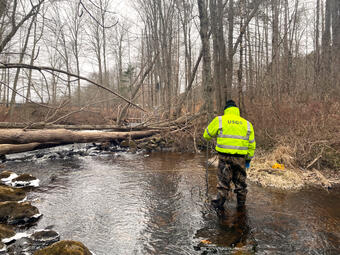Susceptibility of Water Resources to Water-Quality Impairment from Onsite Wastewater Disposal in Rhode Island
The U.S. Geological Survey (USGS), in cooperation with the Southeast New England Program (SNEP) of the U.S. Environmental Protection Agency and the Rhode Island Department of Environmental Management, is investigating the relationship between onsite wastewater treatment systems and nitrogen loads in water bodies in the Narragansett Bay watershed in Rhode Island.

The Rhode Island subbasins for this project are delineated on the above map.
Onsite wastewater treatment systems, including septic systems and cesspools, are major contributors of excess nitrogen to waterbodies in the state of Rhode Island. Nitrogen is a natural part of aquatic ecosystems, but when there is too much nitrogen (typically from human activities such as fertilizer or septic system use), it can negatively affect drinking water resources and promote the growth of nuisance vegetation and algal blooms in surface waters.

USGS is investigating how much nitrogen from onsite wastewater treatment systems is entering into water bodies in the Narragansett Bay watershed in Rhode Island. Nitrogen from onsite wastewater treatment systems can enter the underlying aquifer, be transported by groundwater flow, and later discharge into rivers, lakes, streams, and coastal waters as groundwater flows toward surface water bodies.
This study uses existing data to evaluate how the location and density of onsite water treatment systems relate to nitrogen loads. This information can help Rhode Island Department of Environmental Management identify areas in the state where management activities would be especially effective.
The study area includes the watersheds draining to Narragansett Bay, Little Narragansett Bay, and the coastal ponds along the southern shore of Rhode Island, including the Salt Ponds Region. For the period of 2010-2015, this area had an estimated 120,300 onsite wastewater treatment systems (Narragansett Bay Estuary Program, 2022).
The objectives of this study include:
- Delineate subbasins within Rhode Island and determine onsite wastewater treatment system numbers, density, and other basin characteristics for each subbasin.
- Compile and rank the relative magnitude of total nitrogen input loads from onsite wastewater treatment systems, wastewater treatment facility discharge, fertilizer application, and atmospheric deposition using existing data.
- Estimate the relative susceptibility of freshwater and marine coastal waters to water-quality impacts from onsite wastewater treatment system nitrogen and nitrogen from other anthropogenic (human-originating) sources.
- Collect a limited number of samples for preliminary analysis of correlation between onsite wastewater treatment system density and observed nitrogen and phosphorus concentrations in selected streams.
This study also will be used to help support a groundwater flow and nitrogen transport study that is being done for the Salt Pond region in southern Rhode Island by providing information on anthropogenic nitrogen inputs from onsite wastewater treatment systems: Estimating Nitrogen Loading from Groundwater and Potential Effects of Sea-Level Rise in Rhode Island's Salt Ponds Region.
References
Narragansett Bay Estuary Program, 2022, Wastewater Infrastructure – OWTS Locations – NBEP2017 (shapefile), accessed November 2024, at https://narragansett-bay-estuary-program-nbep.hub.arcgis.com/datasets/c….
Estimating Nitrogen Loading from Groundwater and Potential Effects of Sea-Level Rise in Rhode Island's Salt Ponds Region
The U.S. Geological Survey (USGS), in cooperation with the Southeast New England Program (SNEP) of the U.S. Environmental Protection Agency and the Rhode Island Department of Environmental Management, is investigating the relationship between onsite wastewater treatment systems and nitrogen loads in water bodies in the Narragansett Bay watershed in Rhode Island.

The Rhode Island subbasins for this project are delineated on the above map.
Onsite wastewater treatment systems, including septic systems and cesspools, are major contributors of excess nitrogen to waterbodies in the state of Rhode Island. Nitrogen is a natural part of aquatic ecosystems, but when there is too much nitrogen (typically from human activities such as fertilizer or septic system use), it can negatively affect drinking water resources and promote the growth of nuisance vegetation and algal blooms in surface waters.

USGS is investigating how much nitrogen from onsite wastewater treatment systems is entering into water bodies in the Narragansett Bay watershed in Rhode Island. Nitrogen from onsite wastewater treatment systems can enter the underlying aquifer, be transported by groundwater flow, and later discharge into rivers, lakes, streams, and coastal waters as groundwater flows toward surface water bodies.
This study uses existing data to evaluate how the location and density of onsite water treatment systems relate to nitrogen loads. This information can help Rhode Island Department of Environmental Management identify areas in the state where management activities would be especially effective.
The study area includes the watersheds draining to Narragansett Bay, Little Narragansett Bay, and the coastal ponds along the southern shore of Rhode Island, including the Salt Ponds Region. For the period of 2010-2015, this area had an estimated 120,300 onsite wastewater treatment systems (Narragansett Bay Estuary Program, 2022).
The objectives of this study include:
- Delineate subbasins within Rhode Island and determine onsite wastewater treatment system numbers, density, and other basin characteristics for each subbasin.
- Compile and rank the relative magnitude of total nitrogen input loads from onsite wastewater treatment systems, wastewater treatment facility discharge, fertilizer application, and atmospheric deposition using existing data.
- Estimate the relative susceptibility of freshwater and marine coastal waters to water-quality impacts from onsite wastewater treatment system nitrogen and nitrogen from other anthropogenic (human-originating) sources.
- Collect a limited number of samples for preliminary analysis of correlation between onsite wastewater treatment system density and observed nitrogen and phosphorus concentrations in selected streams.
This study also will be used to help support a groundwater flow and nitrogen transport study that is being done for the Salt Pond region in southern Rhode Island by providing information on anthropogenic nitrogen inputs from onsite wastewater treatment systems: Estimating Nitrogen Loading from Groundwater and Potential Effects of Sea-Level Rise in Rhode Island's Salt Ponds Region.
References
Narragansett Bay Estuary Program, 2022, Wastewater Infrastructure – OWTS Locations – NBEP2017 (shapefile), accessed November 2024, at https://narragansett-bay-estuary-program-nbep.hub.arcgis.com/datasets/c….


